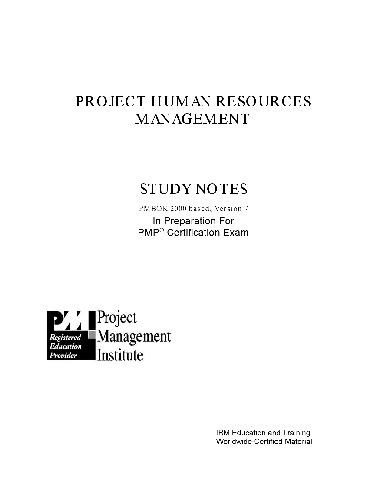Nermien Al-Ali9780471275060, 0471275069
Table of contents :
Comprehensive Intellectual Capital Management : Step-by-step……Page 1
Contents……Page 8
Foreword by Gordon Smith……Page 14
Preface……Page 16
PART ONE: INTELLECTUAL CAPITAL MANAGEMENT……Page 18
Introduction……Page 20
Intellectual Capital and Business Value-The Hidden Resource……Page 22
Business Processes and the Fast Lane of Innovation-Join It or Pull Off the Highway……Page 24
Employees-The Knowledge Processors……Page 26
Does a New Economy Require a New Business Management Approach?……Page 27
IC-Enabled Dynamics and Transformation of Business Management: The Management of Minds……Page 28
The Democratic Organization-Fewer Layers and More Ambassadors……Page 31
Diversify into the Business of Service: The High-Growth Sector……Page 32
Growth through Mergers, Acquisitions, and Strategic Alliances: To Merge or Not to Merge……Page 34
Growth and the Start-Up Business Model: The Idea Incubators……Page 36
The Required Competencies in the Knowledge Economy: Toward Strategic Intellectual Capital Management……Page 37
Innovation Management-Systematize Your Collective Thinking……Page 39
Organizational Culture-The Main Enabler……Page 41
Comprehensive Management of Intellectual Capital-Orchestrate Your Music……Page 42
What’s In a Name?-Defining the Terms……Page 48
Frames of Reference-The IC Model and the Three Circles……Page 50
Value Creation-The Coming of the Pyramids……Page 51
Skandia’s Navigator and the Human Focus……Page 52
The Core Competency Principle and Value Creation……Page 53
The IC Model, Core Competencies Model, and Management……Page 54
Measuring Intellectual Capital……Page 55
IC Measurement Systems-What They Have in Common……Page 57
The Balanced Scorecard……Page 58
The Intangible Asset Monitor-IC Measurement Is Not a Science but a Language……Page 62
The Navigator-Do Not Plan, Navigate……Page 65
The Value of IC Measurement Systems: Where Does All This Leave Us?……Page 66
The Limitation of Financial Reporting……Page 70
The First Approach-IC Reporting in Financial Statements……Page 71
The Second Approach-Separate IC Reporting Models……Page 73
The Knowledge Scorecard……Page 74
Total Value Creation (TVC) Method……Page 75
Suggestions for Developing a Universal IC Reporting Model (UICR)……Page 76
The Stages of Business Management and the CICM Approach……Page 80
The Third Stage-Managing IC as Intellectual Property……Page 82
The CICM Model-Not Another Set of Circles……Page 84
New Management Approach……Page 85
Making Sense-Overcoming Business Skepticism……Page 87
Synchronization and the Role of IC Strategy……Page 88
Unlocking the Mystery of Value Creation and Maximization……Page 89
Setting Objectives-Taking ICM to the Operational Level……Page 90
PART TWO: THE THREE STAGES OF INTELLECTUAL CAPITAL MANAGEMENT……Page 94
Organizational Memory Loss and Brain Drain……Page 96
What Is Knowledge?-Knowledge Is to Know!……Page 98
The Information/Knowledge Interface-Two Sides of a Coin or Two Levels of Consciousness……Page 99
The Individual/Organizational Knowledge Interface-One for All and All for One……Page 100
Strategizing Knowledge Management: Vision and the Role of Leadership……Page 102
Knowledge Audit and Gap Analysis……Page 103
Knowledge Strategies……Page 104
Operationalizing Knowledge Management……Page 107
Augmenting the Organizational Structure-Communities of Practice and the Freedom to Associate……Page 108
Culture, Job Design, and Recruitment Policy……Page 110
The Knowledge Base and IT Infrastructure……Page 112
Storytelling or Anecdote Management-An Ancient Art Revived……Page 114
Conclusion……Page 115
Background……Page 118
The Strategic Level: How the Navy’s CIO Convinced Commanders that KM Is a War Strategy……Page 119
Gap Analysis: Knowing What We Know and What We Need to Know……Page 120
Operationalizing Knowledge Management: The Rough Plan……Page 122
Culture-Not a Question of Sharing But of Security……Page 123
Infrastructure, IT, and the Knowledge Base: The Interrelationship……Page 125
Systems Thinking: The Psychology of Organizational Action and Inaction……Page 127
It Is Not How You Measure But What-Of Limits and Guiding Principles……Page 128
Conclusion……Page 131
Edison’s Style of Innovation Management……Page 134
The Intellectual Capital Concept and Network-Based Innovation……Page 136
Strategizing Innovation Management……Page 137
Innovation Strategies and Competitive Positioning……Page 138
Innovation Portfolio Mix and Risk Management……Page 140
Structural Changes-Loosen It Up or, in Jack Welsh’s Words: “Shake It, Shake It, Break It”……Page 141
A Culture for Innovation-Liberate the Innovative Spirit……Page 144
Human Capital-Idea Banks……Page 147
Customer Capital-The Malleable Innovation Resource……Page 148
Competitive Intelligence……Page 150
Technology Management and Patent Intelligence……Page 151
Conclusion……Page 152
An IP Economy……Page 156
The Birth of IPM and Its Many Shades……Page 157
IPM and the IC Concept-The Job of Everyone Again……Page 158
Strategizing IPM……Page 160
The IP Audit and Portfolio Creation-Not a Legal IP Audit……Page 161
IP Strategies Defining the Focus of IPM……Page 162
A Blueprint for Competitive IP Strategies-Of War……Page 163
Patent Strategies-Of Technological Wars……Page 164
Trademarks/Branding Strategies-Of Wars Over Consumers’ Hearts……Page 165
Copyright Strategies-Of Soft Wars and the Next Hit……Page 167
Value Transference Strategies……Page 168
Blueprint for Commercialization Strategies-Of Peace……Page 169
Operationalizing IPM-With All Due Respect to the Legal Department……Page 171
Structural Changes-Of Strategic Focus and Synergy Teams……Page 172
Cultural Changes……Page 173
Enabling Tools and Practices-IP Valuation……Page 175
Conclusion……Page 176
CHAPTER 9-THE PIONEERS OF INTELLECTUAL CAPITAL MANAGEMENT-SKANDIA AND DOW CHEMICAL……Page 180
The Business Model and the IC Revolution-Carendi and the First Torch……Page 181
Enlightening the Masses-The Navigator and the New Vision……Page 183
The Knowledge Management Stage……Page 185
The Innovation Management Stage……Page 187
Structure……Page 188
The Intellectual Property Management Stage……Page 189
Dow Chemical: The Leap into ICM……Page 190
Petrash’s IAM-Paving the Way……Page 191
Near and the Leap into ICM……Page 192
Dow’s ICM Model……Page 193
The Knowledge Management Stage……Page 194
The Innovation Management (IM) Stage……Page 196
The Intellectual Property (Asset) Management Stage……Page 197
Conclusions on Dow……Page 198
PART THREE: STEP-BY-STEP GUIDE TO THE CICM MODEL……Page 200
The Business Model of the Knowledge Organization……Page 202
Vision and Organizational Soul Searching……Page 203
Find Your People……Page 204
Transform the Organization……Page 205
Culture-The Main Enabler……Page 206
Knowledge Sharing or Idle Socialization……Page 207
Cultural Change-Uncovering the Implicit Values……Page 208
Management Objectives……Page 236
Processes……Page 237
Process 1: Getting Started and Gap Analysis……Page 238
Process 2: Deciding on Innovation Strategies……Page 239
Process 3: Innovation Portfolio Mix……Page 240
Process 4: Structural Changes for IM……Page 243
Process 5: Employee Implementation of Ideas and the Right Culture……Page 245
Process 6: Idea Banks and Employee Innovation……Page 246
Process 7: Implementing the Lead User Method for Breakthrough Innovation……Page 247
Process 8: Technology Management Methods……Page 248
Management Objectives……Page 250
Processes……Page 251
Process 1: IP Audit and Portfolio Creation……Page 252
Process 2: Choosing Competitive IP Strategies……Page 255
Process 4: Building the IP Portfolio: IP Strategy Units……Page 259
Process 5: Leveraging the IP Portfolio: IP Synergy Teams……Page 261
Process 6: Making IPM the Job of Everyone: The IP Program……Page 263
Process 7: Designing Valuation and Assessment Tools……Page 266
The Industrial Variable: Identify the Value Drivers……Page 270
The Organization’s Situation Variable: Do Not Start from Scratch……Page 272
Management Objectives……Page 212
Processes……Page 213
Process 1: Formulation of Knowledge-Based (or IC) Vision……Page 214
Process 2: Cultural Audit and Transformation……Page 217
Process 3: Knowledge Audits……Page 218
Process 4: Strategizing Knowledge Management……Page 225
Process 5: Communities of Practice……Page 228
Process 6: Best Practices……Page 229
Process 7: Knowledge Base and IT Architecture……Page 230
Conclusion……Page 234
Strategic Management……Page 276
Marketing Strategy……Page 279
Organizational Structure……Page 280
Acquisition and Scope of Protection……Page 282
Implications for Legal Management……Page 284
Infringement, Enforcement, and Litigation-What to Do When You Suspect Your Patent Is Being Infringed……Page 285
Acquisition and Scope of Protection……Page 286
Implications for Legal Management……Page 287
Acquisition and Scope of Protection……Page 288
International Treaties and Protection in Other Countries……Page 289
Infringement, Enforcement, and Litigation……Page 290
Acquisition and Scope of Protection……Page 291
International Treaties and Protection in Other Countries……Page 292
Infringement, Enforcement, and Litigation……Page 293
A Summary……Page 294
INDEX……Page 296







Reviews
There are no reviews yet.